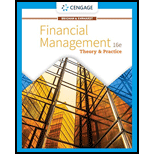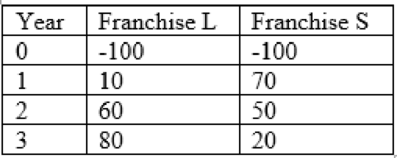
a)
Case summary:
The cash flows of Franchise L's would start off slowly however will rise rather quickly as people become much health-conscious, while the cash flows of Franchise S would start off high however will trail off as other chicken competitors comes inside the marketplace and as people become more health-conscious and avoid fried foods. Franchise L serves breakfast and lunch, whereas Franchise S serves only dinner, so it is possible for person X to invest in both franchises.
Here are the net cash flows (in thousand $)

To determine: The definition of
b)
To determine: The relationship between IRR and YTM and IRR if equal
c)
To determine: The logic behind the IRR method and the franchises should be accepted if they are independent and mutually exclusive.
d)
To determine: Whether IRR changes with respect to change in cost of capital.
Trending nowThis is a popular solution!

Chapter 10 Solutions
Financial Management: Theory & Practice
- A project's internal rate of return (IRR) is the discount rate YTM on a bond. The equation for calculating the IRR is: timing Project A Project B 0 1 2 CFt is the expected cash flow in Period t and cash outflows are treated as negative cash flows. There must be a change in cash flow signs to calculate the IRR. The IRR equation is simply the NPV equation solved for the particular discount rate that causes NPV to equal zero 320 255 The IRR calculation assumes that cash flows are reinvested at the IRR If the IRR is greater ✔than the project's risk-adjusted cost of capital, then the project should be accepted; however, if the IRR is less than the project's risk-adjusted cost of capital, then the project should be rejected ✓✓✓. Because of the IRR reinvestment rate assumption, when mutually exclusive projects are evaluated the IRR approach can lead to conflicting results from the NPV method. Two basic conditions can lead to conflicts between NPV and IRR: ✔ differences (earlier cash flows in…arrow_forwardConsider two investments with the following sequences of cash flows: (a) Compute the i* for each investment.(b) Plot the present-worth curve for each project on the same chart and find the interest rate that makes the two projects equivalent.(c) If A and B are mutually exclusive investment projects, which project is more economically desirable at MARR of 15%?arrow_forwardThe net present value (NPV) of a project is positive when the discount rate used is: Group of answer choices equal to the project's internal rate of return (IRR). greater than the project's internal rate of return (IRR). equal to the yield to maturity of the bonds issued to finance the project. Less than the project's internal rate of return (IRR).arrow_forward
- Assume you have the following asset and liability in your balance sheet Asset - Bond AModified Duration = 1.5 yearsValue = RM1 million Liability - Bond BModified Duration 2.6 yearsValue = RM2 million a. Calculate the duration gaps?b. What is the expected change in Net worth if interest increases by 1%?c. What should or could you to achieve immunised balance sheet?arrow_forwardThe amount of money originally put into an investment is known as the present value P of the investment. For example, if you buy a $50 U.S. Savings Bond that matures in 10 years, the present value of the investment is the amount of money you have to pay for the bond today. The value of the investment at some future time is known as the future value F. Thus, if you buy the savings bond mentioned above, its future value is $50. If the investment pays an interest rate of r (as a decimal) compounded yearly, and if we know the future value F for t years in the future, then the present value P = P(F, r, t), the amount we have to pay today, can be calculated using the formula below. P = F × 1 (1 + r)t We measure F and P in dollars. The term 1/(1 + r)t is known as the present value factor, or the discount rate, so the formula above can also be written as the following. P = F × discount rate (a) Explain what information the function P(F, r, t) gives you. The function…arrow_forwardCan you answer these in Excel (and show any calculation formulas). See the attached image for the information. 1. What is the payack period, NPV, IRR? 2. What happens to the NPV and IRR if initial capital goes up 30%? 3. How much would the selling price have to increase to compensate for 30% in capital costs to the original level in 1.? 4. What is your recomendation?arrow_forward
- The cash flows associated with an investment project are as follows: Project Y (200 000) Year 1 100 000 2 100 000 3 120 000 4 110 000 The discount rate is 8 percent. What's the discount payback period of the projects? (compile a spreadsheet) Calculate NPV, PI of a projects Calculate IRR of a projects Should the firm accept the project? a) b) c) d)arrow_forwardpls refer to the image attached, 1. suppose that you have the capacity to pay, would you rather borrow a loan that is amortized monthly, or one that is amortized quarterly? 2. what is your considerations when availing a loan? (quantitative or qualitative considerations) Discuss.arrow_forwardPercentages need to be entered in decimal format, for instance 3% would be entered as .03. West Coast Chemical Company (WCCC) is considering two mutually exclusive investments - Project A and Project B. The projects' expected net cash flows for Years 0-5 are shown in the spreadsheet provided. Based on the information in the spreadsheet, what is the NPV for Project A and Project B based on the required return of 10%? What is each project's IRR? If the required rate of return for each project is 13%, which project should West Coast select? If the required rate of return is 9%, what would be the proper choice? If the required rate of return is 15%, what would be the proper choice? For each scenario, explain why you chose the particular project. Refer to the Model-Generated Data portion of the spreadsheet and identify at what rate the NPV profiles for the two projects cross. The spreadsheet shows that Project A has a large cash flow in Year 5 associated with ending the project.…arrow_forward
- Consider the following sets of investment projects: (a) Classify each project as either simple or nonsimple.(b) Compute the i* for Project A, using the quadratic equation.(c) Obtain the rate(s) of return for each project by plotting the PW as a function of interest rate.arrow_forwardConsider an investment project, which behaves according to the cash flow (in local currency) below, as well as the respective inflations for the period. In view of the above and knowing that the capital cost of the project is 15% per year, it is requested: a) The values of NPV and IRR b) A graphical sketch of NPVs versus interest rates c) Decision on the feasibility of the project regarding the IRR and NPV indicators Anos = years Fluxo de caixa = cash flow Taxa de inflação do período = period inflation ratearrow_forwardFind the PV and FV of an investment that makes the following end-of-year payments. The interest rate is 8%. Year Payment 1 100 2 200 3 400 Rate = 8% To find the PV, use the NPV function: PV = Year Payment x (1 + I )^(N-t) = FV1 100 1.17 116.64 2 200 1.08 216.00 3 400 1.00 400.00 Sum = ?PV = ?FV of PV = ?arrow_forward
